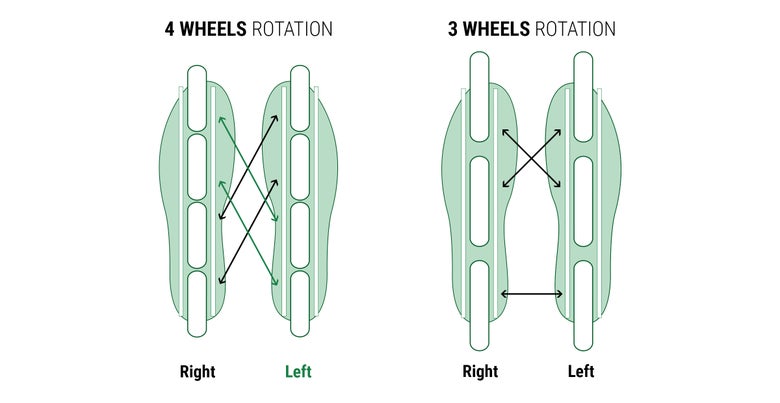How to Rotate Inline Skate Wheels and When to Replace
A Guide to Wheel Maintenance and Replacement
It’s critical that close attention is paid to the wear patterns on your wheels and rotate accordingly. Rotating your wheels regularly will lead to increased safety, prolonged wheel life and ultimately, a better overall skating experience.
Here are some of the most common factors that lead to wheel wear:
- Turning and Braking Methods (and frequency)
- Skating Surface
- Wheel Quality (urethane and hub)
- Skater Weight
- Rotation Frequency
- Skating Frequency
Rotating Wheels
Similar to tires on your car, it is important to rotate your wheels to increase longevity. Rotating your wheels will help keep the wear pattern consistent, extending the life of the wheels and providing a smoother ride. There are many different ways to rotate your wheels, the techniques listed below are tried, true, and effective for most skaters.
When inspecting your wheels it’s good to start at the front, this area almost always wears faster and typically on one skate more than the other. This comes from skating tendencies when turning or stopping.
Depending on your skating usage you want to switch wheels from one skate to the other when you rotate. For three-wheeled skates, you'll take the front wheels and replace them with the middle wheel on the opposite skate and then you'll swap the back wheel on each skate for each other. For four-wheeled skates, take your first two wheels on the left skate and swap them with your back two on the right skate, repeat for other four wheels. (see image below)
If you would like to go above and beyond wash the wheels when you rotate them. This will help to keep your bearings clean from grime and build up. First remove the wheels from the frames and set aside the axles and bearings (do not wash the axles or bearings). Fill a container with some warm water and dishwashing soap to hand wash the wheels. Use a rag and tumble the wheels around. Take caution to not use too warm of water and not allow the wheels to soak as it could otherwise the urethane can get deformed.
When is it Time to Replace?
If you’re noticing chunks of urethane missing, cracks in the hub or a sharp tip forming in the middle (typically from wear on one or both sides), you should have replaced your wheels yesterday. Otherwise, if you’re starting to notice a decline in performance, noise vibrations or an uncomfortable ride, it’s time to consider replacing your wheels.
Typically, more experienced riders who rotate their wheels often will only need to change a couple of wheels at a time. Newer skaters, or skaters who don’t rotate wheels as often, will often end up having to change the whole set all at the same time.
Finding Your Wheel Size
The frame on your skate will determine the size of your wheel replacement. Most frames list the maximum wheel size that can be mounted on the side. If your frame no longer has this information present, look up your skate’s specifications on the y’old inter webs.
Use caution when purchasing new wheel sizes. Purchasing a smaller wheel size can cause gaps in your frame that may lodge rocks or sticks. It will also lower the brake, making it potentially tough to skate or even dangerous. Use caution when purchasing a larger wheel, a wheel that exceeds the maximum size stated on the frame will not have the necessary clearance to spin freely.
How to Change/Remove Your Skate Wheels
1. Unscrew and remove the axle bolts from the front wheel with an Allen wrench.
2. Pull the front wheel out of the wheel frame.
3. Remove the bearings and spacer from the wheel. All components should slip out together.
4. Place the spacer and bearings into the new wheel.
5. Place the new wheel on the wheel frame.
6. Replace the axle and tighten it using the Allen wrench. If your spacer is aluminum, tighten the axle as far as it will go. If your spacer is plastic, tighten the axle almost as far as it will go, then loosen it slightly. Spin the wheel to see how easily it rolls. If it doesn’t spin freely, loosen the axle. If the wheel wobbles, tighten the axle.
7. Repeat the previous steps for the remaining wheels.

